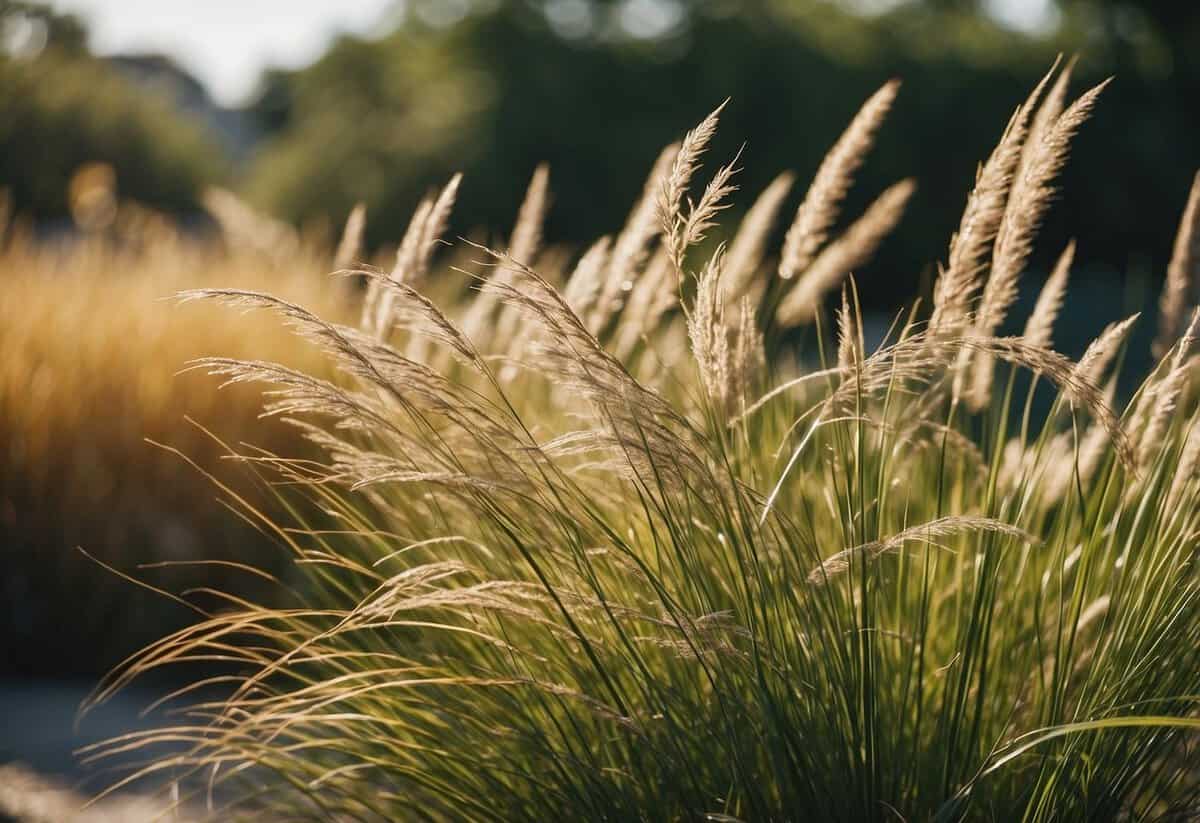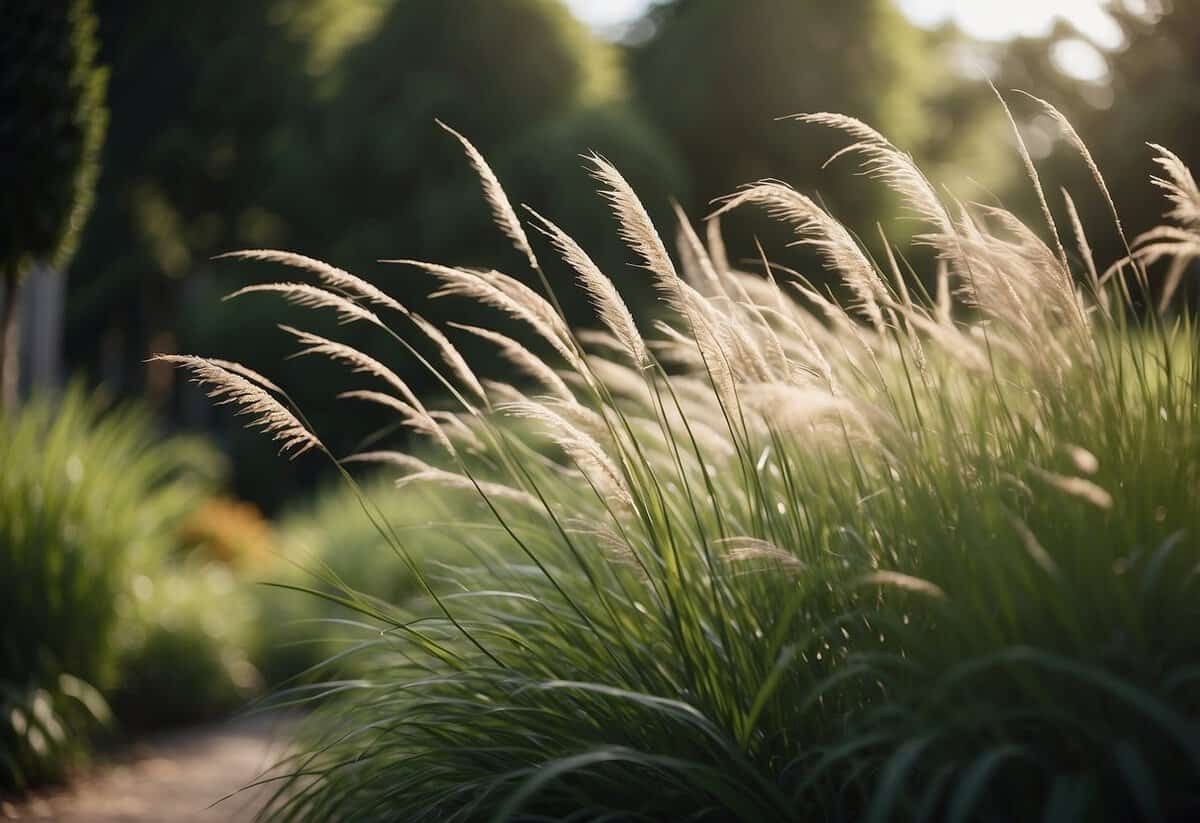Ornamental Grass Garden Ideas: Creative Landscapes for Your Home
Ornamental grasses can bring a unique charm to any garden, offering texture, color, and movement that enhance your outdoor space. These versatile plants work well in a variety of settings, from containers on your patio to lush garden corners.

Wondering how to incorporate ornamental grasses into your landscape design? You’re about to discover simple and creative ideas that will elevate your garden’s appeal, making it a delightful place for relaxation and beauty.
1) Blue Fescue

Blue Fescue is a stunning ornamental grass. It has silvery-blue foliage and pale green flowers that turn buff-colored as they mature. Gardeners love its fine texture.
This grass grows best in USDA zones 4 to 8. It’s drought-tolerant, making it a good choice for low-maintenance gardens. Blue Fescue adds vibrant color to your garden beds and borders.
Plant Blue Fescue in clusters along borders or as ground cover. For best growth, choose a spot with well-drained soil and full sun. This grass stays green year-round, adding winter color to your garden.
2) Japanese Blood Grass

Japanese Blood Grass adds a striking red color to your garden. It grows in dense clumps reaching about 12-18 inches tall. This grass thrives in full sun and well-drained soils, making it drought-tolerant once established.
You might want to plant it in a mass planting for a sea of red foliage. It also works well as a border plant, adding texture and color to your garden beds. Consider using it in containers to brighten up your patio or deck.
3) Purple Fountain Grass

Purple fountain grass is a fantastic addition to your garden. It has elegant, arcing spikes of nodding purplish flowers that spray out beautifully. The long, slender, burgundy leaves add amazing color and texture.
This grass grows fast and loves at least partial sun. It’s hardy in warmer zones, but in colder areas, treat it as an annual. Perfect for mixed borders or containers, giving your space a striking look. If you have more ideas, let us know!
4) Feather Reed Grass

Feather Reed Grass is a great addition to your garden. It stands tall and adds a vertical element to your landscape.
This grass does well in full sun, needing at least six hours of sunlight each day. It also prefers rich, moist, well-draining soil.
You should water it weekly, especially when the top inch of soil feels dry. In early spring, trim old foliage to encourage new growth.
Feather Reed Grass looks beautiful when paired with other perennials like lavender. It’s versatile and adds texture to garden beds and borders.
5) Mexican Feather Grass

Mexican feather grass, also known as Nassella tenuissima, is a graceful addition to your garden. Its fine, feathery blades create a soft, flowing look that moves gently with the breeze.
Plant this grass in full sun and well-drained soil. It is drought-tolerant and requires very little care. This makes it a low-maintenance choice for busy gardeners.
You can pair Mexican feather grass with flowering plants like white coneflowers or lavender to create a striking landscape design. Their textures and colors complement each other beautifully.
6) Liriope

Liriope, also known as monkey grass or lilyturf, is a popular choice for ornamental grass gardens. These plants are tough and can thrive in various conditions. You will find Liriope especially useful for creating borders or ground cover.
Liriope comes in two main types: Liriope muscari forms clumps, while Liriope spicata spreads quickly. They both produce lovely lavender flower spikes in late summer, adding a pop of color to your garden.
To plant Liriope, space each tuft about a foot apart in soil rich with organic matter. Keep the soil moist initially, but once established, Liriope is drought-tolerant and low-maintenance. This makes it a stress-free addition to your garden. For more details, check out The Spruce.
Liriope thrives in full sun to part shade, making it versatile for different areas of your garden. This grass can handle various light conditions and still look lush and vibrant.
Use mulch around the plants to keep weeds at bay and help soil retain moisture. This little effort goes a long way in keeping your Liriope healthy.
7) Silver Grass

Silver Grass, also known as Miscanthus sinensis, is a beautiful and versatile ornamental grass. It adds a striking look to your garden with its tall, arching leaves. This grass is very easy to grow and requires little maintenance.
In autumn, the foliage turns a lovely orange-gold, and in winter, the dried seed heads add interest. You can find varieties like Miscanthus sinensis ‘Flamingo’ which has unique rose-pink flower plumes.
This grass grows best in full sun and adapts well to different soil types. It’s also drought-tolerant, making it a reliable choice for any garden.
8) Switchgrass

Switchgrass is a great choice for any garden. It’s a warm-season grass that starts growing in mid to late spring. This grass produces beautiful feathery flowers from July to September.
It grows best in full sun and is great at handling different types of soil. You can plant switchgrass in zones 4 to 9. It also adds a nice upright texture to your garden.
9) Zebra Grass

Zebra Grass, also known as Miscanthus sinensis ‘Zebrinus’, is a striking choice for any garden. It features unique leaves with yellow horizontal stripes that make it stand out.
This ornamental grass can grow up to 7 feet tall, with the foliage reaching about 5 feet. Its plumes add extra height and interest.
You can plant Zebra Grass in various soil conditions, and it is quite low-maintenance. Make sure to space the plants 3 to 5 feet apart. This will allow them to grow without overcrowding. For more details, visit this helpful guide.
10) Pampas Grass

Pampas Grass is a showstopper. It can grow up to 10 feet tall, making it a great choice for adding height to your garden. Its fluffy, cream-colored plumes are beautiful and create a sense of movement.
You can plant Pampas Grass as a standalone feature or in groups to create a natural screen. It thrives in sunny spots and well-drained soil.
Learn more about different types of Pampas Grass and how to incorporate them into your garden.
Benefits of Ornamental Grasses

Ornamental grasses offer multiple advantages for your garden. They require little upkeep, support eco-friendly practices, and enhance the visual appeal of your landscape.
Low Maintenance
Ornamental grasses thrive with minimal care. They typically do not need frequent watering, making them a great choice for drought-prone areas. Most varieties are resistant to pests and diseases, reducing the need for chemical treatments. These grasses also do well in poor soil conditions, minimizing the necessity for fertilizers.
Trimming these grasses usually happens just once a year, in late winter or early spring. This easy upkeep makes them perfect for busy gardeners or those wanting a low-effort landscape.
Sustainability
Ornamental grasses contribute to sustainable gardening practices. They help conserve water due to their low irrigation requirements. Additionally, these plants improve soil health by preventing erosion with their extensive root systems.
Many ornamental grasses are native species that provide habitat and food for local wildlife. Using these grasses supports biodiversity and helps create a balanced ecosystem in your garden.
Aesthetic Appeal
Ornamental grasses add unique textures and colors to your garden. Their variety in height and form allows you to create dynamic and visually interesting landscapes. For example, tall grasses like switchgrass add vertical interest, while shorter ones like blue fescue work well as ground covers.
These grasses often change color with the seasons, adding year-round interest. In winter, their seed heads can also provide a beautiful contrast against the snow.
Design Tips for Ornamental Grass Gardens

Ornamental grasses can add texture, color, and movement to your garden. To maximize their effect, it’s essential to choose the right types, pair them well with other plants, and consider how they’ll look across different seasons.
Choosing the Right Varieties
Selecting the right ornamental grass varieties is crucial. Begin by considering your garden’s climate and soil conditions. Some grasses, like fountaingrass, thrive in moist environments, while others, like switchgrass, prefer well-drained soil.
Height and Spread: Think about the space each grass will occupy. Tall grasses, like miscanthus, create excellent backdrops, while shorter ones, like blue fescue, are perfect for borders.
Color and Texture: Different grasses bring unique colors and textures. For instance, ruby fountain grass offers striking maroon foliage all year round.
Maintenance: Consider the maintenance levels. Some, like zebra grass, can be more challenging to manage, while others, like feather reed grass, are easy to care for.
Combining with Other Plants
When mixing ornamental grasses with other plants, balance is key. Use grasses to complement flowering plants or shrubs.
Contrast and Balance: Combine soft, mounding grasses with plants that have bolder shapes. For example, pair* fountaingrass* with large-leafed perennials. This creates a visually interesting garden.
Color Harmony: Match grasses with plants that enhance their color. For instance, the gray-green foliage of tufted hair grass looks beautiful next to silver or purple plants.
Layering: Use layering techniques to add depth. Taller grasses can form the backdrop, medium heights fill the middle, and shorter types line the front. This layered approach ensures all plants are visible and allows for an organized appearance.
Seasonal Interest
Ornamental grasses can shine in every season. Plan ahead to ensure your garden remains attractive year-round.
Spring and Summer: Use emerging foliage in spring for a fresh look. In summer, grasses often fade to the background to let flowering plants take the spotlight.
Autumn: Late summer and early autumn are peak times for many grasses. Their plumes and changing colors add beauty as other plants start to fade.
Winter: Many grasses remain attractive in winter, providing structure and interest. Grasses like switchgrass and miscanthus can show off their appealing seed heads and sturdy stems, even under a light snowfall.







